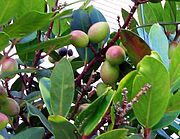bio.wikisort.org - Plant
Persea indica is a large, evergreen tree in the laurel family (Lauraceae), native to humid uplands on Madeira and the Canary Islands in the North Atlantic.[1] It belongs to the genus Persea, a group of evergreen trees including the avocado. It is threatened by habitat loss.
| Persea indica | |
|---|---|
 | |
Conservation status | |
| Scientific classification | |
| Kingdom: | Plantae |
| Clade: | Tracheophytes |
| Clade: | Angiosperms |
| Clade: | Magnoliids |
| Order: | Laurales |
| Family: | Lauraceae |
| Genus: | Persea |
| Species: | P. indica |
| Binomial name | |
| Persea indica (L.) Spreng. | |
It has been introduced to a number of islands in the nearby Azores.[1]
Overview
This article needs additional citations for verification. (August 2015) |
The family Lauraceae was part of Gondwanaland flora. There they spread over most of the continent. The genus Persea died out in increasingly xerophytic Africa, starting with the freezing of Antarctica about 20 million years ago and the formation of the Benguela current. The genus is extinct in Africa, save for P. indica, which survives in the fog shrouded mountains of the Canary Islands, which with Madagascar, constitute Africa's Laurel forest plant refugia.
Fossil evidence indicates that the genus originated in West Africa during the Paleocene, and spread to Asia, to South America, and to Europe and thence to North America. It is thought that the gradual drying of Africa, west Asia, and the Mediterranean from the Oligocene to the Pleistocene, and the glaciation of Europe during the Pleistocene, caused the extinction of the genus across these regions, resulting in the present distribution.
Persea indica is a species exclusive to Laurisilva, since this habitat is constantly threatened by encroaching agriculture, the laurel forest animal or vegetal species had already become rare in many of its former habitats and are threatened by habitat loss.
Fossil record
Fossils of Persea indica have been described from the fossil flora of Kızılcahamam district in Turkey, which is of early Pliocene age.[2]
See also
References
- Fernandes, F.; da Silva Menezes de Sequeira, M.P. (2017). "Persea indica". IUCN Red List of Threatened Species. 2017: e.T30329A102153566. doi:10.2305/IUCN.UK.2017-3.RLTS.T30329A102153566.en. Retrieved 15 November 2021.
- Kasaplıgil, Baki (1977). "Ankara, Kızılcahamam yakınındaki Güvem köyü civarında bulunan son tersiyer kozalaklı-yeşil yapraklı ormanı" [A Late-Tertiary Conifer-Hardwood Forest From the Vicinity of Güvem Village, Near Kızılcahamam, Ankara] (PDF). Bulletin of the Mineral Research and Exploration (in Turkish and English). Ankara: General Directorate of Mineral Research and Exploration. 88: 94-102.
На других языках
- [en] Persea indica
[ru] Персея индийская
Персея индийская (лат. Persea indica) — вид вечнозелёных деревьев из рода Персея семейства Лавровые (Lauraceae).Другой контент может иметь иную лицензию. Перед использованием материалов сайта WikiSort.org внимательно изучите правила лицензирования конкретных элементов наполнения сайта.
WikiSort.org - проект по пересортировке и дополнению контента Википедии



